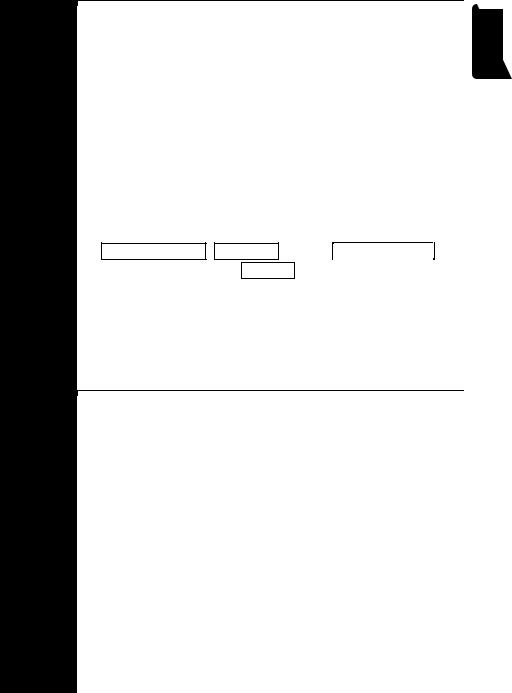
LAW / Referencing for Law Students / AGLC 3rd ed
.pdf
8 Part I — General Rules
21 Defamation Act 2005 (Vic) s 37.
22 Ibid s 38.
…
156Rosalyn Higgins, Problems and Process: International Law and How We Use It (Clarendon Press, 1994). Cf Barendt, above n 18, 67.
157Barendt, above n 18, 69. [Not: Ibid 69 or Barendt, ibid 69.]
…
204Higgins, above n 156, 220.
205Ibid 222, 239.
1.4.2Above and Below
Rule |
‘Above n’ should be used where a source has been cited: |
|
|
•in a previous footnote other than the immediately preceding footnote; or
•in the immediately preceding footnote, if it is not the only source in that footnote.
However, ‘above n’ should not be used for:
•cases, international judicial decisions and other materials in chapters 2, 9, 10, 11 (in accordance with rules 2.14, 9.5, 10.3, 11.4);
•legislation and other materials in chapter 3 (in accordance with rule 3.9);
•certain sources in chapter 6 (in accordance with rule 6.16);
•treaties (in accordance with rule 7.6); and
•UN, WTO, GATT and EU documents (in accordance with rules 8.5, 12.4, 13.3),
and analogous sources in Part V.
Citations using ‘above n’ should appear as follows:
Author’s Surname , above n Footnote Number , Pinpoint .

Australian Guide to Legal Citation |
9 |
The ‘footnote number’ is the footnote in which the source is first cited.
Where the author is a body (such as a government department), the body’s name should be included in place of the author’s surname.
Where there is no author or editor, the title (or an abbreviated form of the title) should be included in place of the author’s surname.
Where works by different authors with the same surname are cited, the authors’ full names as they appear on the source should be included in place of the author’s surname (to avoid ambiguity).
Where multiple works by the same author are referred to, subsequent references should appear as follows:
Author’s Surname , Short Title , above n Footnote Number ,
Pinpoint .
‘Above’ and ‘below’ may also be used to direct the reader to portions of text (to particular footnotes, page numbers or numbered sections of the text). To direct the reader to more than one footnote, ‘above nn’ or ‘below nn’ should be used.
‘Op cit’, ‘loc cit’, ‘supra’ and ‘infra’ should not be used.
Examples 9 Catharine MacMillan, Mistakes in Contract Law (Hart Publishing, 2010) 38.
…
20 MacMillan, above n 9.
…
22N C Seddon and M P Ellinghaus, Cheshire and Fifoot’s Law of Contract (LexisNexis, 9th ed, 2008) 867.
…
27 Seddon and Ellinghaus, above n 22, 20.
…
31‘Obama Moves to Bring Russia in from the Cold’, The Age (Melbourne), 21 September 2009, 10.
…
34 ‘Obama Moves to Bring Russia in from the Cold’, above n 31, 10.
General
Rules

10 Part I — General Rules
…
39Sir Anthony Mason, ‘Future Directions in Australian Law’ (1987) 13 Monash University Law Review 149.
40Keith Mason, Constancy and Change: Moral and Religious Values in the Australian Legal System (Federation Press, 1990).
…
43 Keith Mason, above n 40, 28.
…
47Kim Rubenstein, ‘Meanings of Membership: Mary Gaudron’s Contributions to Australian Citizenship’ (2004) 15 Public Law Review 305.
48Kim Rubenstein, Australian Citizenship Law in Context
(Lawbook, 2002).
…
61Rubenstein, Australian Citizenship Law in Context, above n 48, 65–74.
62Rubenstein, ‘Meanings of Membership’, above n 47, 307–11.
…
74See above n 21 and accompanying text.
75See above nn 31–3.
76See below Part III(A)(1).
1.4.3Short Titles
Rule Short titles are an abbreviated form of the title of a source. A short title should appear in italic text and be enclosed in (non-italic) inverted commas and parentheses after the initial citation of a source. It should appear after any pinpoints or parenthetical clauses in the citation. Only one short title should be included in the first citation to a source.
Cases, legislation, certain sources in chapter 6, treaties, international judicial decisions and UN, WTO, GATT and EU documents (and analogous sources in Part V) may be given short titles for subsequent references in accordance with rules 2.14, 3.9, 6.16, 7.6, 8.5, 9.5, 10.3,

Australian Guide to Legal Citation |
11 |
11.4, 12.4, 13.3).
For reports and other similar secondary sources (and additionally where indicated throughout the Guide), a short title based on the title of the source may be used with an ‘above n’ reference (instead of the author’s surname). Subsequent references should then appear as follows:
Short Title , above n Footnote Number , Pinpoint .
Examples 2 Parliamentary Joint Committee on Corporations and Financial Services, Parliament of Australia, Opportunity Not Opportunism: Improving Conduct in Australian Franchising (2008) 4 (‘Opportunity Not Opportunism Report’).
…
16Opportunity Not Opportunism Report, above n 2, 7.
1.4.4At
Rule Where the same source is cited multiple times within the same footnote, the full citation should not be repeated and ‘at’ should precede subsequent pinpoint references. However, it is not necessary to repeat a pinpoint reference using ‘at’ if the subsequent pinpoint reference is the same as that immediately beforehand.
Where there are multiple sources in a footnote, ‘at’ should be used only to refer to the immediately preceding source.
‘At’ can be used regardless of how the source is first cited in a footnote (whether in full, using ‘ibid’ or using ‘above n’).
Examples 291 Commonwealth, Parliamentary Debates, Senate, 17 June 2008, 2626. The Minister explained that ‘[t]here may be a number of reasons that prevent a person’s immediate removal, … includ[ing] … issues surrounding the acquisition of the person’s travel documentation’: at 2627. [Not: … documentation’: ibid 2627.]
292Ibid 2625. The Minister noted that his Department had ‘grouped the data to prevent the identification, or potential identification, of any one person.’ [Not: … any one person’: at 2625.]
General
Rules

12 Part I — General Rules
...
378Cf Andrew Lynch and George Williams, ‘Beyond a Federal Structure: Is a Constitutional Commitment to a Federal Relationship Possible?’ (2008) 31 University of New South Wales Law Journal 395; Tony Blackshield, ‘New South Wales v Commonwealth — Corporations and Connections’ (2007) 31
Melbourne University Law Review 1135. Blackshield notes a failed ‘attempt to confine the scope of s 51(xx)’: at 1137. Lynch and Williams argue that the Commonwealth nevertheless has ‘inadequate powers to fully regulate industrial relations’: Lynch and Williams, above n 378, 397 n 10. [Not: … industrial relations’: at 397 n 10.]
1.5Quotations
1.5.1Short and Long Quotations
Rule
Examples
In the body of the text and in the footnotes, short quotations (of three lines or less) should be incorporated within single quotation marks.
Long quotations (of more than three full lines) should appear indented from the left margin, in a smaller font size, and without quotation marks. Legislative and treaty extracts, regardless of length, may also appear this way.
Where a long quotation appears in a footnote, the citation to the source should appear on the line directly preceding or following the quotation.
Priestley JA stated that ‘there is a close association of ideas between the terms unreasonableness, lack of good faith, and unconscionability.’67
The Judge stated:
Thus elaborating, the first question is whether ‘a financial benefit is given’ within the meaning of s 229 of the Corporations Act (in relation to the prohibition on related party benefits without member approval). The second question is whether the exception for arm’s length terms in s 210 of the Corporations Act is made out …135

Australian Guide to Legal Citation |
13 |
The Constitution provides in s 92 that:
On the imposition of uniform duties of customs, trade, commerce, and intercourse among the States, whether by means of internal carriage or ocean navigation, shall be absolutely free.
__________
138 The claims are inferred from the rhetorical question:
Do we respond [to the problems in remote communities] with more of what we have done in the past? Or do we radically change direction with an intervention strategy matched to the magnitude of the problem?
Commonwealth, Parliamentary Debates, House of Representatives, 7 August 2007, 10 (Malcolm Brough, Minister for Families, Community Services and Indigenous Affairs and Minister Assisting the Prime Minister for Indigenous Affairs).
1.5.2Punctuation Introducing Quotations
Rule A short quotation should be integrated into the sentence. No specific punctuation is required to introduce it. It may be introduced by a colon.
No punctuation should be used where a sentence leads seamlessly into a long quotation. However, a colon is typically the appropriate punctuation to introduce a long quotation.
Examples This was most obvious in relation to proof of title to land, which ‘necessitated tracing title back through an unbroken chain of events and documents, perhaps as far as the Crown grant.’7
As the Privy Council commented: ‘it does not, in their Lordships’ opinion, assist to rationalise the defence … as concerned to protect security of receipts and then to derive from that rationalisation a limitation on the defence.’8
However, he ultimately rejected the submission that the detention of these children was indefinite and explained that
General
Rules

14 Part I — General Rules
the period of detention had a clear terminus. This (putting it broadly) is the voluntary election of the children (through their parents) to leave Australia or the completion of the legal proceedings brought by the parents on the children’s behalf …9
In 2005, the matter finally reached the House of Lords, whereupon Baroness Hale declared:
My Lords, this is, and has always been, a case about children, their rights and the rights of their parents and teachers. Yet there has been no one here or in the courts below to speak on behalf of the children. … The battle has been fought on ground selected by the adults.10
1.5.3Quotations within Quotations
Rule
Examples
In short quotations (integrated within the text), double quotation marks should be used for a quotation within the quoted text, single quotation marks for a further quotation inside that, and so forth.
In long quotations, single quotation marks should be used for a quotation within the quoted text, double quotation marks for a further quotation inside that, and so forth.
Quotation marks in quoted text should be changed to adhere to this rule.
He observed that ‘the threshold for determining that an international organisation has “effective control” over an operation ought to be high.’
They summarised Kolb’s view as follows:
Kolb describes good faith as a general principle of international law that has as its aim ‘to blunt the excessively sharp consequences sovereignty and its surrogates … may have in the international society, in everincreasing need of cooperation’ …
1.5.4Punctuation within Quotations
Rule Punctuation marks at the end of quoted text (full stops, commas, etc) should not be included in a quotation unless the punctuation mark forms part of and is important to the quotation. Other punctuation marks within a quotation should be retained in quoted text.

Australian Guide to Legal Citation |
15 |
Hyphens, en-dashes and em-dashes in quotations should be altered to adhere to rule 1.6.3. Full stops in abbreviations in quotations should be omitted to adhere to rule 1.6.1.
Examples As Walker observed, the ‘call for states to grant asylum to those persecuted because of prostitution or homosexuality was made over 20 years ago’. [Original: … over 20 years ago, and since then …]
Carmody J goes on to offer the following interpretation of the ‘paramount but not sole’ formulation appearing in previous cases:
The best interests of the child(ren) concerned, both in the short and longer term, and not the interests or needs of the parents (let alone the interests of either one of them) are the paramount consideration. However, they are not the sole factor. [Original: … sole factor. The …]
The observation that ‘there is a sharp student–teacher dichotomy that ought to be observed’ was repeated. [Original: … a sharp student-teacher dichotomy …]
1.5.5Capitalisation at the Start of Quotations
|
|
Rule |
|
If a quotation begins a sentence, the first letter of the quotation should |
|
|
|
|
be capitalised. Otherwise, the first letter of the quotation should not be |
|
|
|
|
capitalised. Both may require use of square brackets to indicate |
|
|
|
|
amendment to the quotation (see rule 1.6.6). |
|
|
|
|
Where a colon precedes a quotation, the first letter of the quotation |
|
|
|
|
should appear as it does in the original (whether capitalised or not). |
|
|
|
|
|
|
|
Examples |
|
According to the Oxford English Dictionary, an ‘exception’ is |
|
|
|
|
[s]omething that is excepted; a particular case which comes within the |
|
|
|
|
terms of a rule, but to which the rule is not applicable; a person or thing |
|
|
|
|
that does not conform to the general rule affecting other individuals of the |
|
|
|
|
same class.30 |
|
|
|
|
Subsequently, in Dextra, the Privy Council asserted inequitability as |
|
|
|
|
the central rationale of the defence: |
|
|
|
|
The defence should be regarded as founded on a principle of justice |
|
|
|
|
designed to protect the defendant from a claim to restitution in respect of |
|
|
|
|
a benefit received … in circumstances in which it would be inequitable to |
|
|
|
|
pursue that claim, or to pursue it in full.94 |
|
|
|
|
|
General
Rules

16 Part I — General Rules
1.5.6Ellipses
Rule
Examples
Omissions from a quotation should be indicated by an ellipsis ( … ). A space should precede and follow an ellipsis (however a space should not separate an ellipsis and a footnote number, in accordance with rule 1.1.2).
Where the omitted text immediately follows a complete sentence, a full stop (or other closing punctuation) at the end of that sentence should be included before an ellipsis.
A full stop should not be included after an ellipsis (whether to show that words before the end of the sentence have been omitted, or to show that an omission falls between complete sentences in the source).
‘Leaders’ (ellipses at the start of quotations) should not be included.
An ellipsis should be added to or replace any punctuation at the end of a long quotation if the quotation does not end with an appropriate closing punctuation mark.
In applying Sullivan, his Honour considered that the High Court had
emphasised … that foreseeability of harm to the fathers was not sufficient to ground a duty of care. … Sullivan v Moody is not on all fours with the present case because it involved a statutorily imposed duty … Notwithstanding this difference, in my view Sullivan v Moody gives guidance … [Not: … imposed duty … . Notwithstanding …]
In Australian Capital Television, McHugh J noted:
If the institutions of representative and responsible government are to operate effectively … the business of government must be examinable and the subject of scrutiny, debate and ultimate accountability at the ballot box. The electors must be able to ascertain and examine the performances of their elected representatives …84
1.5.7Editing Quotations
Rule If a quotation is altered, the alteration should be included within square brackets (in accordance with rule 1.6.6). Omissions from a quotation should be indicated by an ellipsis (in accordance with rule 1.5.6).

Australian Guide to Legal Citation |
17 |
Spelling and capitalisation within quotations generally should not be changed (except as required by rule 1.5.5).
All case names, statute titles, treaty titles and titles of sources that should be italicised according to the rules in this Guide should also be italicised where they appear in quotations (in accordance with rule 1.8.2).
Examples The Court observed that ‘the [Commonwealth] Act was clearly within power.’ [Original: … the Act was clearly within power. …]
Additionally, in Tasmania, an as yet insufficiently tested provision in the Anti-Discrimination Act 1998 (Tas) appears to enlarge the concept and application of anti-vilification laws in relation to conduct which ‘offends, humiliates, … insults or ridicules’. [Original: … offends, humiliates, intimidates, insults or ridicules …]
As Bunjevac has observed:
According to the International Organization of Securities Commissions, this perception was significant in structured finance ratings because the rating served as an independent informational input about complex transactions. [Not: … Organisation …]
1.5.8[sic]
|
Rule |
|
‘[sic]’ (meaning ‘thus’) should be inserted after a significant error in |
|
|
|
material being quoted. Insignificant errors should be left as they |
|
|
|
appear in the original and should not be followed by ‘[sic]’. |
|
|
|
The term ‘[sic]’ should not be used to mark non-Australian English |
|
|
|
spelling or non-standard capitalisation. |
|
|
|
Although a quotation is obviously the work of another author, ‘[sic]’ |
|
|
|
may be inserted after discriminatory or offensive expressions in |
|
|
|
quotations. The preferable solution, where possible, is to paraphrase |
|
|
|
the passage to avoid any such expression. |
|
|
|
|
|
Example |
|
He stated brazenly: ‘They misunderestimated [sic] me.’ |
|
|
|
|
General
Rules
